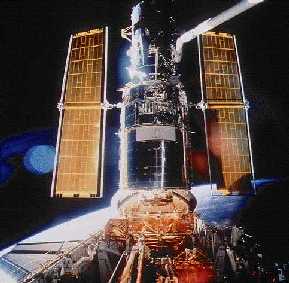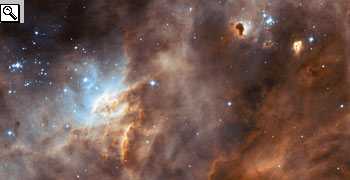The Hubble Space Telescope
To overcome these drawbacks the Hubble Space Telescope (HST) was positioned 600 km from the Earth's surface. This telescope has a 2.4 metre mirror and 6 instruments to observe from ultraviolet
The resolution
Most of the images on these pages are taken by this telescope.
 |
Fig. 1: The HST (in the middle) leaving the Shuttle; to the left and to the right of the HST there
is an opened solar panel. (Credit: Foto NASA) |
The idea of a space-orbiting telescope was conceived in 1962 in the USA, at the National Academy of Science; the real project started only in 1977 and the telescope was completed in 1985. In 1990 the Space Shuttle![]() Discovery carried it into orbit around the Earth.
Discovery carried it into orbit around the Earth.
Thanks to the good scientific results obtained, the telescope will be kept at least until 2007.
The JWST![]() (James
Webb Space Telescope), the successor to the HST, should be launched next.
(James
Webb Space Telescope), the successor to the HST, should be launched next.
 Fig. 2: Example of the HST's capabilities. (Credit: Foto NASA, ESA; 01/07/2004) |
On the left is an example of the HST's capabilities.
It shows the star formation zone N11B in the Large Magellanic Cloud (LMC), at 160 thousand light years Click on the image to enlarge. |
To see lots more images taken by Hubble go to the NASA photographic archive.
The Webweavers: Last modified Mon, 11 Oct 2004 10:35:51 GMT